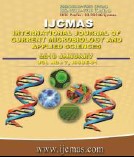


 National Academy of Agricultural Sciences (NAAS)
National Academy of Agricultural Sciences (NAAS)

|
PRINT ISSN : 2319-7692
Online ISSN : 2319-7706 Issues : 12 per year Publisher : Excellent Publishers Email : editorijcmas@gmail.com / submit@ijcmas.com Editor-in-chief: Dr.M.Prakash Index Copernicus ICV 2018: 95.39 NAAS RATING 2020: 5.38 |
Garlic (Allium sativum) is second important allium crop grown in India after onion. It spite of exclusively propagated by vegetative method, crop shows wide variation in agro-morphological traits. For developing varieties with good yield and other favourable traits use of breeding techniques in an option. But in garlic, inability of formation of seed becomes barrier for using introgression breeding techniques. This limits the genetic enhancement of crop, however clonal selection narrow down the gene pool of crop. Further garlic enjoys countywide distribution and worldwide dynamic importance. However in India its growth habit restricted to Rabi season only. ICAR-DOGR serve as National Active Germplasm Site (NAGS) for garlic, where 700 garlic germplasm being maintained, collected from different states of India. For checking agro-climatic adaptability of garlic genetic resource present experiment was laid out. Here, total 625 garlic accessions were evaluated during kharif season for nine quantitative and five qualitative traits in two replications for two years. In pooled analysis only 68 bulb forming accessions were selected for further studies. Average values of different traits were taken for secondary analysis as non-significant difference found between years to accessions interaction. Cluster analysis (Ward 1963 method) based on fourteen agro-morphological traits sorted 68 genotypes into five main groups as cluster 1 (11 accessions), cluster 2 (7 accessions), cluster 3 (3 accessions), cluster 4 (33 accessions), cluster 5 (14). Dendrogram based on hierarchal clustering grouped the genotypes based on their morphological traits, however the grouping of genotypes did not correspond with their geographic origin. Characters like marketable yield, polar diameter, equatorial diameter, average bulb weight, number of cloves per bulb and TSS were found to be major traits in distinguishing major cluster of garlic genotype at phenotypic level. Highest genetic distance was reported between accession 202 and DOGR-499 (14.44), however accession 695 and 14 found to be most similar with minimum genetic distance i.e. 0.95. Principal component analysis revealed that first five component contribute to maximum 95% of variability. This study is first report that covers characterization and adaptation of garlic genotypes during kharif season.
 |
 |
 |
 |
 |